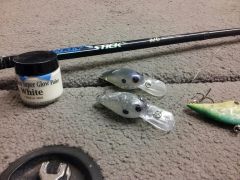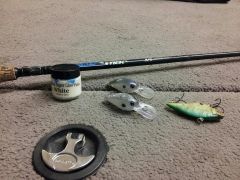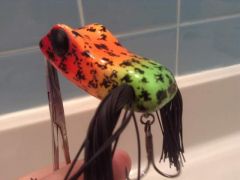-
Posts
14,726 -
Joined
-
Last visited
-
Days Won
364
Content Type
Profiles
Articles
TU Classifieds
Glossary
Website Links
Forums
Gallery
Store
Everything posted by mark poulson
-
Truly flat sides help. The larger the surface that needs to wiggle, the more water resistance. Like putting your hand out a car window, flat at first, and then making a fist. The flat hand creates more air resistance.
-

Painting/clear Coating Premade Jointed Lure Body Blanks
mark poulson replied to aulrich's topic in Hard Baits
Since the bodies are hard plastic and waterproof, you should be able to use any top coat that will protect your paint from water. You can't stop a toothy critter from abusing your bait, but that's the whole point, isn't it? -

Predator Bass Wiggle Wart Is A Salmon Killer
mark poulson replied to mark poulson's topic in Hard Baits
Honestly, I don't know. It is the only glow paint I've ever tried (thanks again BobP). I find I can mix their power into soft plastics, and it makes them glow, too. I also use their powder to make glow in the dark eyes on my frog baits. -

Predator Bass Wiggle Wart Is A Salmon Killer
mark poulson replied to mark poulson's topic in Hard Baits
Barry, Cooch told me about the catch and release in the San Joaquin, where they don't spawn, and the catch and keep in the Sacramento, where they do. Kinda bassackwards. Bob, That fish twisted the rear hook hanger almost 90 degrees, so I don't trust it to hold much longer. I have several more that I'm going to "light up". I'm also going to put it on some of my spoons. Thanks for the idea, again. -
Ryan, I have found walking baits to be the most forgiving of all builds. Using your eye to shape them works, as long as you have the ramped chin, the right line tie and hook placement, and the right ballasting. I've found that walking baits need to sit tail down at rest, at anything from a 45 degree angle to almost level. The amount of hang down decreases with bait size for me, since bigger baits are harder to get up and moving if they sit too far down in the water. I put my ballast more toward the rear with smaller baits, like a Sammie, and move it closer to the center of the bait with larger baits, like Punkers. If you have a commercial bait the same basic size to use as a guide, it will help a lot. We all learn from other people, so this isn't cheating. Balsa baits are the most lively, and the most fragile, so be sure and use the search feature here to see how to make them stronger without making them too heavy. Good luck, and keep posting as you continue your build.
-

Predator Bass Wiggle Wart Is A Salmon Killer
mark poulson replied to mark poulson's topic in Hard Baits
JR, When I finally got it unhooked, I wasn't sure it would survive. I had put it into my livewell with the manual fill on, so I could get the hooks out without keeping it out of the water. It took several minutes, because the #4 EWG treble was really embedded in it's jaw. I left it in the livewell with it running, figuring I'd keep it fresher that way, since it was on it's side and then belly up. But it's gills were pumping, so I waited to see what would happen. It righted itself after about ten minutes, so I put some Rejuvenade into the livewell, just to help it recover. By the time I released it, using my net, it swam away strongly. Trust me, if it had died, I would have taken it home and eaten it, but it lived, and was returning home to spawn, so I ate frozen pizza instead! -

Predator Bass Wiggle Wart Is A Salmon Killer
mark poulson replied to mark poulson's topic in Hard Baits
First of all, I need to thank http://www.tackleunderground.com/community/gallery/image/15228-glo-paint-wart/ http://www.tackleunderground.com/community/gallery/image/15229-glo-paint-wart-2/ As a hobby builder, and an avid fisherman, it's really fun when something I do works! -
Here's the glo painted wiggle wart I used to catch a big salmon, along with the same bait without the glo paint, for comparison. This is the actual Glonation paint I used, and an old Yozuri trap that also has the paint. The trap caught a 6 lb largemouth, and the paint, protected only by a coat of clear nail polish, has held up for at least four years. It caught fish last week!
-
Here's the glo painted wiggle wart I used to catch a big salmon, along with the same bait without the glo paint, for comparison. This is the actual Glonation paint I used, and an old Yozuri trap that also has the paint. The trap caught a 6 lb largemouth, and the paint, protected only by a coat of clear nail polish, has held up for at least four years. It caught fish last week!
-
A while back I bought a bunch of Pred. Bass' wiggle wart knockoffs, with rattles, and painted them in a translucent shad pattern, for our gin clear SoCal lakes. They caught fish. Since I moved north to the CA Delta, I haven't had clear water. So I decided to put some GloNation white paint over one of the translucent painted warts, and seal it with clear nail polish. Well, it is very visible. I fished it for the first time today, and caught largemouth, stipers, and one Salmon! My scale wouldn't hold on it's hooked jaw, so I didn't get to weigh it, but it was longer than my live well, and almost fell out of the net! I caught it on 15lb BPS mono, on a med. lite Stacey King cranking rod that is 10+ years old. It took me two minutes to get it up to the net. At first I thought it might be a striper, until I saw it's tail. A beautiful fish, released to spawn. Oh, it did break one of the hooks off of the front treble, and the next fish, a striper, opened the rear hook's split ring. I'm going to make another tomorrow, and retire the one I fished today. It deserves a rest.
-
Have you tried spray paint as a release coating, since you're making mold masters, not baits?
-

Painting/clear Coating Premade Jointed Lure Body Blanks
mark poulson replied to aulrich's topic in Hard Baits
Were I painting it, since it's plastic and totally waterproof, I'd do my paint job, and then hang the lure from the nose, with the tail also held down, so the lure remains rigid. I'd brush some concrete sealer (I use AC1315) onto each section and the hinge interior, starting at the head and working my way down. My stuff flashes off fast, so the brushing should take care of any drip issues. But you can use a lot of other clear coats. The concrete sealer is just something I find easy to use. As long as your clear coat covers any painted areas, you shouldn't have any problems. -
Would using a harder lead prevent this?
-
His daughter posted on Facebook that the doctors now think it's MS. They told me that, too, 40 years ago, and it never developed, unless insanity is one of the symptoms. Fingers crossed!!!
-
Does anyone here have a link to an underwater test of the effects of texture on a soft bait's hydraulic profile? I'm hoping to see something like the wind tunnel testing of air foils, but in the water.
-
I keep my AC1315 in a gasketed lid glass dipping jar. It used to hold dill pickles. I poured the jar almost full from the original can, and haven't put any more in since. I only dip a couple of times a year now, and it's still fine, even though it's probably at least three years old by now.
-
Years ago I made some reverse joint swimbaits, as a test of the jointing. I found the reverse joints didn't move as well at low speed. http://www.tackleunderground.com/community/gallery/image/4214-reversed-joint-7-trout/
-
-
Is there a clear lacquer paint available to coat your own blades?
-
Bob, That has been my experience, too. All of the baits I painted with GloNation paint still glow, and it's been several years for some of them.
-
Is that the kind of tissue paper that is used in gift wrapping?
-
Dave, What effect do you think having the line tie up away from the face of the lip has, if any?
-
I wonder if it's a combination of the cupped eyes acting as additional diving surfaces, plus the line tie is out in front of the bill. I've found that extending the line tie out from the bill on my crankbaits makes them more stable at faster retrieves, but I can't tell how it affects diving depth. No pool, no test tank, no clear water. Boo hoo! )
-
Brushing the Bondo into the details first is key, even if you have to mix a second batch to pour over it to make the mold body. The second pour will bond to the initial detail Bondo.
-
Ed, Since I began using BJ soft plastic, and a little heat stabilizer (too much will yellow all by itself), I can get clear plastic, and reheat, too.







